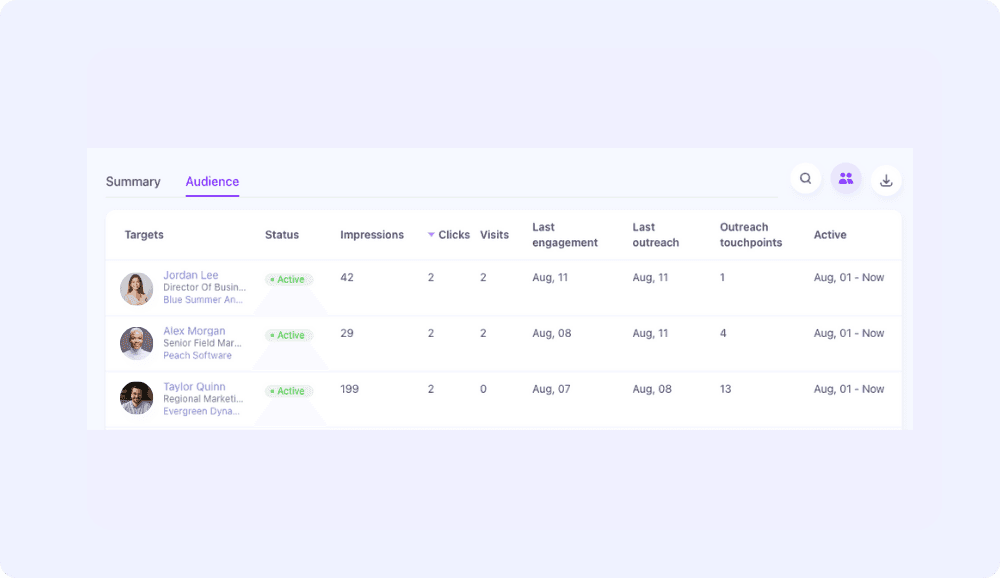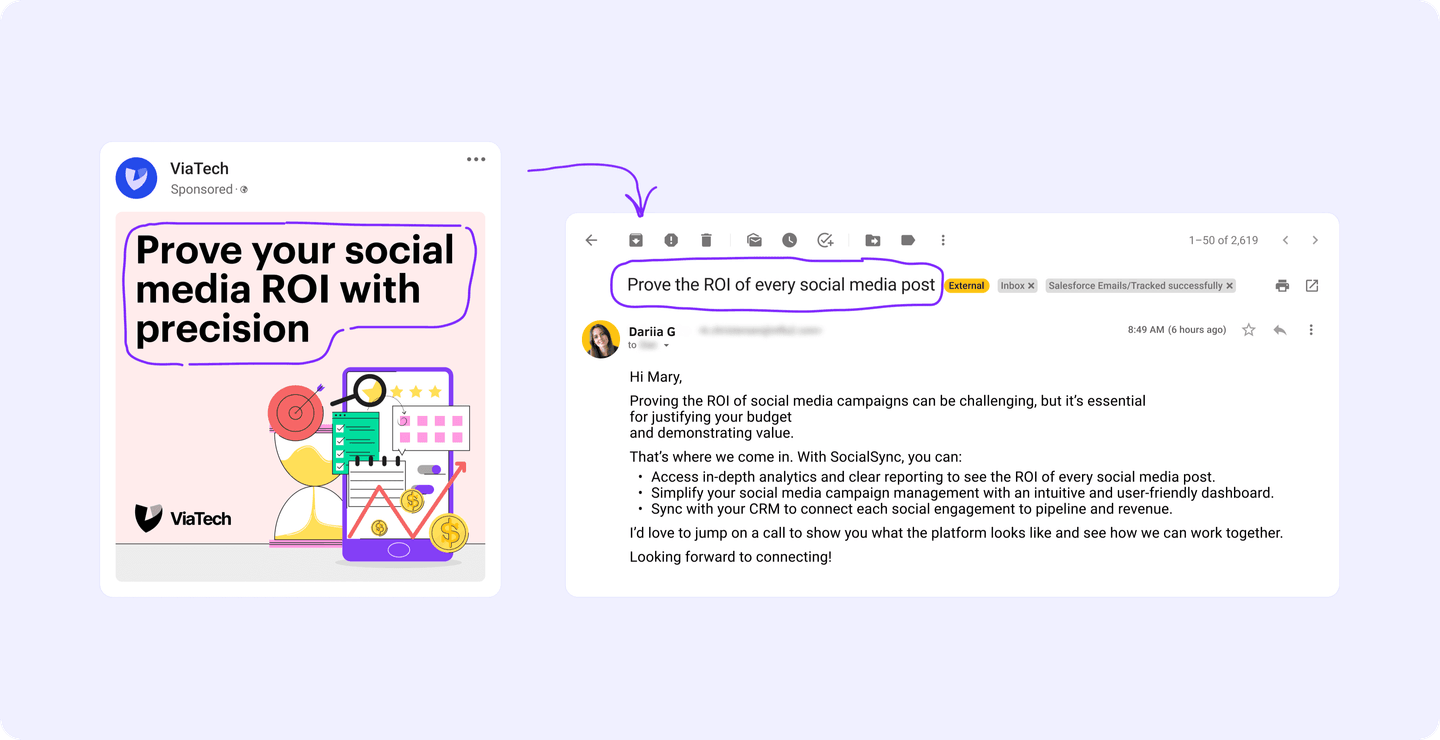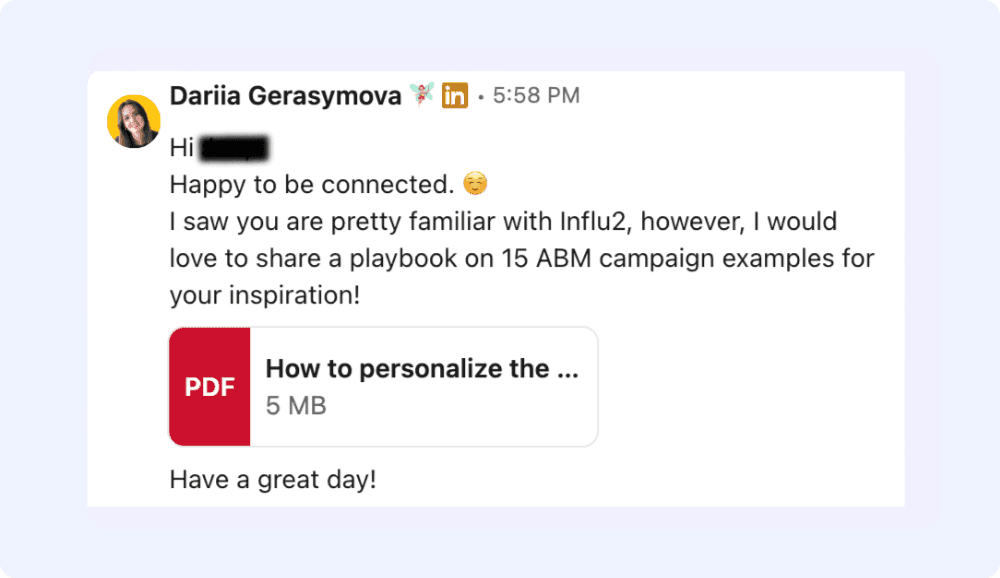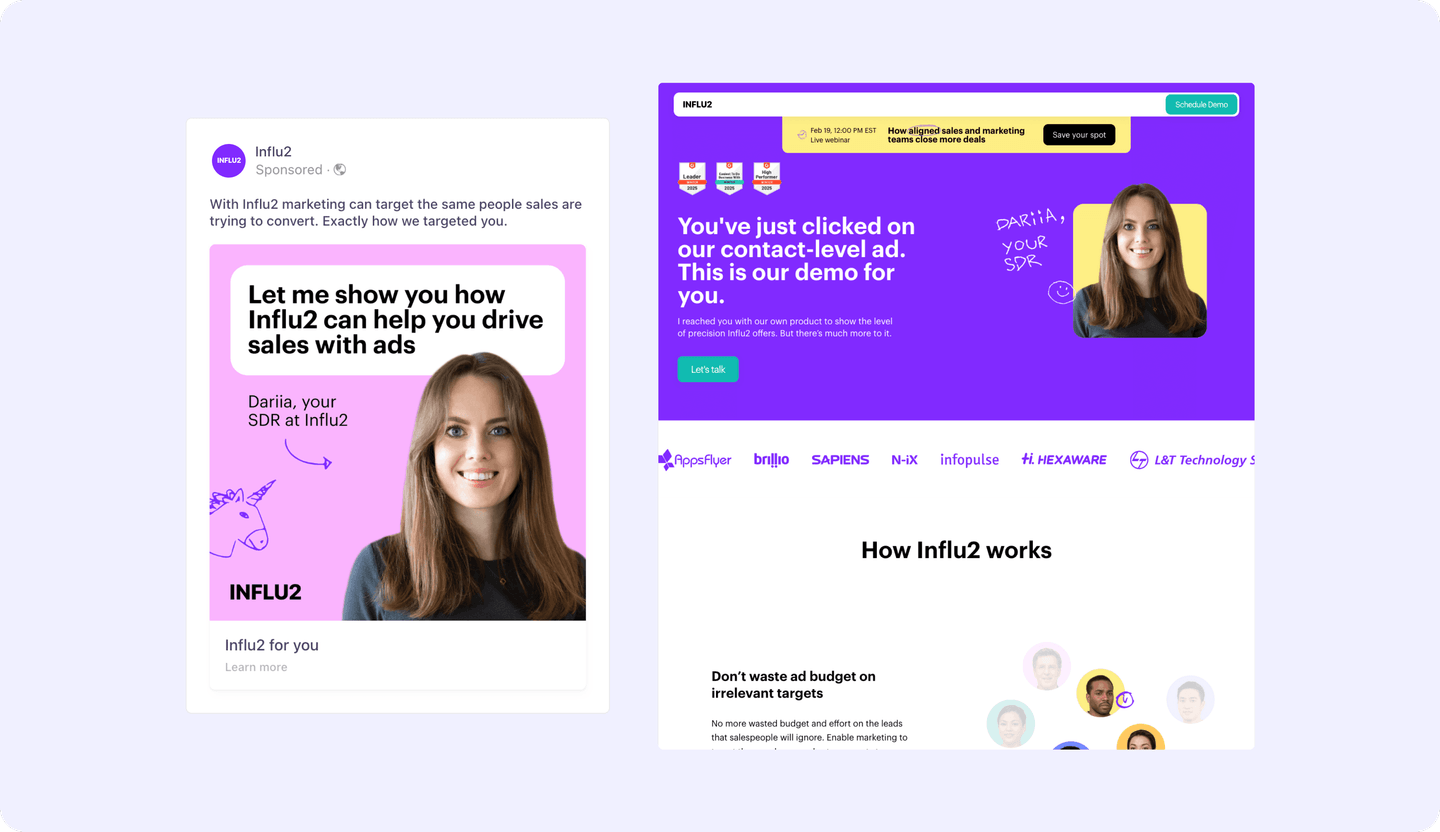An SDR’s Guide to Signals: How I Sell Smarter and Book More Meetings

Everyone talks about signals. No one teaches you how to actually use them.
From the outside, it might look like magic—an ad click becomes a conversation, a site visit becomes real momentum. All of a sudden, you’re pulling prospects out of hats and opening invisible doors.
But trust me, it’s not magic. It’s just context, creatively used.
As an SDR, I take a creative, human-centric approach. Over the years, it has served me well and led me to hit (and exceed) quota quarter after quarter.
Here’s the crash course: Behind every contact-level signal is a person. And every signal tells you a little bit more about who they are and how to approach them creatively. Let me show you how it works.
The right signal + the right message = my outbound philosophy
Hi there! I’m Dariia, a marketer-turned-SDR. I spend my days at Influ2, using contact-level ABM to develop creative and compelling outbound outreach.
Yes, I use Influ2 to sell Influ2. And it works well.
You might be wondering: “How well?”
The last three quarters have looked something like this: I hit 100%, then 123% and 117% of my quota. I’m telling you—it works.
- Influ2 supplies the signals
- I write creative messages designed to resonate
- Bingo! It’s a winning strategy
Here’s how you do it.
Step one: Searching for the right signals
Every day starts with a little bit of (digital) snooping. I sign in and check for new signals from our ad campaigns. Then, I start to interpret them.
On its own, a signal is just that: a signpost telling me: “Hey! This person from my dream company might be interested in X.”
But if I look at the context around it—things like the type of signal—that information becomes a map that leads me to create stronger outreach. In the dashboard, I look at ad clicks and page visits to help me get a sense of a contact’s interest in Influ2.

You know as well as I do that SDRs are working with an abundance of signals and not a lot of time. To survive, prioritization is key. Look at the signals that show the most interest and start there. My favorite combination are ad clicks + page visits (Influ2 shows you exactly which ad they clicked and what page they viewed).
Once you know who may be interested, you’re ready to reach out.
Step two: Sending the right messages
Say you notice a contact clicked on an ad and spent a meaningful amount of time on your website.
What do you do next?
Maybe don’t send a creepy message that reads like you’re tracking their browser history. Instead, keep the momentum going and continue the message that caught their eye. A few things I like to do:
- Borrow the ad copy: Something in that ad spoke to them. Connect your outreach to that interest to avoid sending generic messages that don’t resonate. Here's a fictional example.

- Adapt to the source: If a prospect clicked on an educational ad, don’t send a “Saw you downloaded our guide. You ready to buy yet?” email. Tailor your message to the context you have, and meet them where they are.

Familiar copy and “wait, I’ve seen this before” imagery wins me responses and cuts through the noise. If it sounds straightforward, it’s because it often is.
Sleuth out the right signals. Send the contacts behind those signals the right message.
Of course, there’s more to it than that. Over the years, I’ve acquired the hard-earned knowledge you’ll need as you embed signals into your outbound strategy.
A few things I’ve learned the hard way (so you don’t have to)
There are more than a few things I wish I’d known when I was getting started as an SDR—way more than I could fit in this blog post.
Here are a few, just so you don’t have to learn them the hard way:
1. Creativity isn’t just a marketer’s tool
A mistake I often see SDRs make (and one I made myself) is falling into generic, formulaic outreach.
Yes, it’s easy to scale. But it isn’t what builds relationships or wins business. It’s the thoughtful, strategic outreach that does.
Let me give you an example.
So, we all know that ads won’t always actively engage a contact. However, they do quietly build context and familiarity, which gives you a leg up ahead of any cold outreach you’re planning.
One thing we do is launch warm-up ad campaigns to prime a contact before we reach out.
What’s on them? Me, telling you I’ll be reaching out.

Once my face is in circulation on a contact’s feed, I’ll drop them a line. They already know what’s coming their way—and might even be thinking about Influ2 before I reach out.
We do the same thing after we have an initial conversation. The momentum doesn’t slow if I’m popping up again, paired with copy that screams: “Remember me?”
And that’s just one example of what we can do with contact-level ads.
There are so many cool things you can do (here are some examples). Don’t get stuck in a sea of generic. It won’t get you anywhere, plus it’s way less fun.
2. An old signal isn’t necessarily a useless signal
There’s so much pressure to make use of the signals at your immediate disposal. The instant a new signal lands in your lap, the clock starts ticking. You’ve got 24 hours before it's discarded.
While the value of signals degrades over time (because our memories are only so good), that doesn’t mean that historic signals don’t have value—and can’t act as a lever for capturing a contact’s attention.
Older signals can still offer valuable context. While a signal from three months ago might be a little stale, it just might do the trick. We all have busy lives. Maybe the ad resonated then, but now is just a better time to connect.
Keep an eye on past campaigns and a pulse on your CRM. Used right, yesterday’s signals can become today’s booked meetings.
3. You can sell on social media, but don’t make it weird
Too many SDRs treat social media like just another platform for outreach—and it can be. But you need to take a different approach.
For instance, I like to use LinkedIn to keep tabs on the contacts I’m targeting. But I’m cognizant that social media is for being social, not for selling. It’s in the name.
It’s a gradual process, for sure. But it works like this:
- I engage with their posts
- I ask thought-provoking questions
- I do my best to be a positive part of their community
- And, slowly but surely, I lay the groundwork for the “why Influ2” conversation
We also recently released a new feature in Influ2 that auto-filters social activity to capture meaningful social signals, so Marketing and Sales can act on them quickly. Trying that out, I’ve found that strong signals aren’t limited to ads—they can come from anywhere, and you need to be ready to adapt your outreach to the source.
Keep a meaningful, genuine pulse on social media. Approach contacts with curiosity, not sales tactics. When used the right way (like a normal human), social media signals will eventually lead to sales.
Your prospects are people too. Treat them like it.
Contact-level signals give me the context to sell better. But it’s my dedication to curious, creative, and human-centric outreach that seals the deal.
With the right signals, the right message, and the right ad at the right time, you’ll find yourself getting more meetings on the calendar and making stronger progress toward your quarterly targets.
Do you want to sell smarter? Did this article do its job and get you interested in Influ2? Either way, drop me a line.

Dariia is an extremely creative sales person combining her human-centric outreach with building personal brand for about 5 years. She switched to B2B SaaS sales after 7 years in marketing, so she combines the best practices between sales and marketing when selling Influ2.


